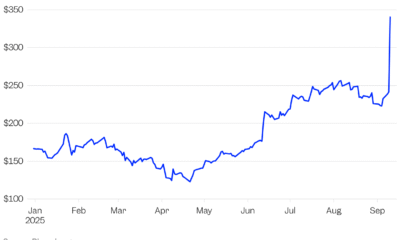Business
AI Boom Reminds Henry Blodget of Dot-Com Boom

In the late 1990s, everyone was convinced that the internet was the future — and that by buying the stock of internet companies like the theGlobe.com you could get really rich.
They were half-right: You’re reading this on the internet. But all that remains of theGlobe is a mothballed web domain.
We could see the same thing this time around with AI, says Henry Blodget. And he says that wouldn’t be a bad thing.
Blodget has a very particular perspective on booms and busts, since he was a central figure in the rise and fall of the first internet bubble. On the way up, he was a celebrated Wall Street analyst; afterward, the Securities and Exchange Commission charged him with fraud — a complaint he settled without admitting or denying guilt.
After the dot-com era, Blodget went on to found the publication you’re reading now (I was his first hire), and is now putting out his own publication and podcast.
Blodget’s bubble argument goes like this: We see them all the time, and they can often be a good thing, by focusing money and attention on important things. But they will also inevitably deflate — so the trick is figuring out how to play them. Which, for most people, involves not playing at all.
Blodget and I talked about the AI boom and his new media aspirations in the latest episode of my Channels podcast. What follows is an edited excerpt of our conversation.
Peter Kafka: You got a very close look at the internet bubble of the 1990s. How does it compare to what we’re seeing now?
Henry Blodget: This bubble phenomenon is the way markets and technology innovate.
It’s often portrayed as a morality play: “It’s gonna end! It’s so stupid. All this money is gonna be burned, and people are losing their minds.”
What’s really going on is it’s a huge R&D lab. Hundreds of billions of dollars, probably trillions at this point, are being thrown at something that most of us recognize as a huge future opportunity, the same way a lot of people recognized the internet as a huge future opportunity in the mid-1990s to late 1990s.
And with any R&D, most of the experiments are going to fail.
What is going to happen is that at some point, this amazing fundamental growth wave — which is amazing, people are buying and using these products, and there is a lot of revenue being generated and so forth — at some point, we are going to get out ahead of ourselves.
We’re going to have a setback, and there’s going to be a huge reordering of everything, and a whole bunch of companies are going to fail. And then the next generation of companies or the survivors from this first crash will go on and inherit the earth, and AI will be bigger than everybody thinks it will be, although different.
That is the consensus. I think it’s probably right.
Then the only question is where are we? Are we in 1996 or 1997? Or are we in the fall of 1999, right on the precipice of the crash? And what I will respectfully submit is that there is no way to be super-confident about that.
The premise here is that AI is real, and it’s not going away. But some bubbles are just bubbles, right? People bought tulips and they went up in value. Or a couple of years ago, very serious people thought Web3 was a big deal worth taking seriously. It appears to have gone nowhere. Are you confident that AI is real and important things will come of it?
I think so. I look at the adoption of Chat GPT and Claude and some of the other models. There is a lot of fundamental adoption there.
As many people have pointed out, there is not enough adoption or revenue to even begin to fund the extraordinary capital expenditures that are being made to provide these services.
And one of the things that is worrisome is that the models seem to be progressing more slowly than people thought. And their usefulness is not increasing as fast as people thought. And most companies are actually really struggling with how to use it.
Like companies that started a website in 1999 and then realized it didn’t transform their business. They just had a website.
Right. But it feels like this is real. If you look at what Open AI is already doing, the fundamental product is going gangbusters.
The problem with the valuations of all these stocks is that they are priced for the same kind of growth continuing for decades. So if you run into a problem like AOL ran into, which was they couldn’t make the transition from dial-up to broadband, their valuation is going to get destroyed.
Unlike the web bubble, you can’t really be a stock-picker this time around: If you want to invest in an AI company, you can buy Nvidia, and that’s about it.
If you’re a normal person and you’re interested in AI and you think this is real, but also a bubble, what do you do?
For most of us, the truth is you have a balanced portfolio of index funds with a good, healthy slug of cash and bonds in there. You don’t bet on anything.
One of the things that makes this look very much like the 1990s bubble is how AI investing is now juicing the rest of the economy. A lot of the economic growth we’re seeing right now is coming from these investments in data centers. Microsoft, Meta, and a few others are investing hundreds of billions in them.
Paul Kedrosky wrote a great piece about how everyone’s saying it’s just like the railroads — you make the big investment up front and then you get the benefits for a long time.
But as Paul points out, this is not like laying a fiber line that is going to be great for the next 25 years, or a set of railroad tracks you can use over the next hundred years. These things have a three-to-four-year life.
Because Nvidia will come out with new chips. The current chips will be outmoded. A lot of this massive investment in data centers is going to be obsolete soon. There isn’t a huge payback time.
So we are really setting up for a situation in which a lot of the fundamental performance is being juiced by every company in the world panicking and saying, “I gotta invest in AI”. And all venture capital money is going there and so forth.
At some point, that party is likely to stop, and when it does, there’s going to be this big reordering. Lots of companies will go.
It’s not going to shock me if in seven years [we realize] OpenAI took a wrong turn two years ago and went down some path, and somebody else comes up with something new that is the Google of the era.
And Google didn’t really appear until 2000. They missed the whole 1990s, and yet they were the one that you wanted, because they got it right.
Business
Bedford tech company expands with an eye on AI

Artificial intelligence (AI) is an important subject to Nick Soggu, CEO of SilverTech, a Bedford-based digital experience agency.
AI is near and dear to Soggu not only as SilverTech expands its business pursuits with the recent purchase of another tech company, Paragon, but also personally to Soggu as he works toward a doctorate degree in AI and machine learning.
AI has far-reaching consequences for business and for society as a whole, according to Soggu.
“The ethics and the threat side of things is very real. I think as these reasoning models are being created and now start to get more advanced, they do take on interesting types of personalities,” Soggu said.
“These models are getting to that level of thinking and cognizant behavior capabilities, where they’re starting to do more than regurgitate facts and provide the next best word fit,” he added.
Enhancing the use of AI was cited as one of the benefits cited in SilverTech’s recent purchase of Paragon, which is based in Ohio and brings to the table a broad client list that deepens SilverTech’s portfolio.
SilverTech’s headcount, as a result of the purchase, grew from around 85 to about 150, making it “uniquely positioned to lead innovation and drive transformative growth in the tech sector,” according to the statement that announced the purchase July 24.
Soggu said there were two primary reasons for the Paragon purchase: one technical, one strategic.
The technical part has to do with what Soggu called “digital experience products,” otherwise known as content management systems (CMS products such as WordPress) or digital experience platforms (DXPs).
“Paragon happens to be in a market providing the same types of services we do, but they’re working with a whole different set of these digital experience solutions. And so what you have is the best of both worlds when you combine the two firms,” said Soggu.
Strategically, said Soggu, Paragon had clients in certain areas that SilverTech did not.
“They work with just like we do with a variety of brands that are different than we are, in verticals that are different than we are. And at the end of the day, it’s a diversification strategy in the client concentration,” said Soggu. “They don’t work with a lot of banks and credit unions that we do, as an example, but they have a lot of direct-to-consumer type brands like Ugg and brands of that nature that they’re providing services for. And so it expands our customer hopeful portfolio as well.”
The AI component adds some horsepower to the organization, according to Soggu.
“The future is really about what we’re going to be doing together using artificial intelligence and machine learning technologies for our client base, and the combined horsepower, from an engineering perspective, that we’re able to bring to the table,” said Soggu.
According to the company, the combined strength of the companies offers the following benefits:
Scale the delivery of AI-powered personalization, predictive analytics and intelligent search.
Accelerate innovation in machine learning, conversational interfaces and process automation.
Deepen customer research and deliver digital strategy that is aligned with business strategy.
Expand CMS and DXP platform expertise with top-tier technology partnerships and solutions, and is certified and well credentialed in Sitecore, Progress Sitefinity, Kentico, Hubspot, Contentstack, Contentful, Salesforce, Sanity and Big Commerce.
“This acquisition brings together Paragon’s deep enterprise experience and consulting expertise with SilverTech’s strengths in digital marketing, media and managed services,” said Jeff McPherson, chief growth officer at SilverTech. “Together, we are expanding our ability to serve a broader range of markets with a powerful mix of strategic insight and technical innovation — helping clients harness data, personalize experiences, improve decision-making and drive automation.”
In that growing use of AI, there are threats and opportunities, as Soggu has studied both as a tech executive and PhD student.
“The world of deep fakes and the world of creating content that looks and feels like human created content — and it’s very compelling content — that’s a dangerous and slippery slope,” said Soggu. “I think there’s a lot, from an ethics perspective, that’s yet to be determined, things that we should be certainly concerned about.”
At the same time, according to Soggu, AI can produce efficiencies that ultimately benefit a business.
“The opportunities are very compelling in terms of efficiency gains, in terms of work output gains,” he said. “Large corporations are seeing upwards of 30% to 50% gains in efficiency and work output.”
In his work, Soggu said AI can be applied to some quality assurance tasks.
“We can put a website through its paces using AI tools and technologies to do user testing much more efficiently and effectively than we can with five or six humans involved in that process,” Soggu said.
Business
Why Trusted Data Is Key to Transformational AI-Driven CX

From boardrooms to shop floors, companies are moving quickly to embed AI into their operations. The goals are clear: drive efficiencies, reduce costs, and deliver smarter, faster, more personal customer experiences.
This makes a lot of sense given that today 89% of businesses are expected to compete primarily on CX. However, the results aren’t always matching the hype.
A recent Gartner study found that while enterprise AI adoption is rising, real impact is often elusive. The reason? Many businesses are still operating with disconnected systems and disjointed data. Without a strong foundation, AI can’t deliver what it promises.
Siloed systems aren’t just a technology problem—they’re a business barrier.
The CX Disconnect: When Fragmentation Undermines Intelligence
Too many organizations still rely on a patchwork of tools for customer experience, supply chain, finance, and HR. While these point solutions solve individual challenges, they create friction and disconnect across the business. In an AI-powered world, friction is the enemy.
AI thrives on complete, clean, and contextualized data to function effectively. If your marketing, sales, service, and fulfillment teams cannot see the same data in real time, or trust that it’s accurate, your AI strategy will not be set up to succeed.
With the best intentions to embrace AI in an effort to achieve incredible efficiency, instead, customers will still lose valuable time on manual integration, inconsistent customer experiences, and AI outputs that are only as good as the (fragmented) data feeding them. The delightful experience aspirations turn into trust lost and frustration all around.
Modular Innovation, Meet Enterprise Intelligence
SAP has reimagined enterprise management with SAP Business Suite, representing a fundamental shift from traditional ERP systems to a modular, composable architecture that integrates AI, data, and applications into a unified platform.
Grounded in harmonized, semantically rich data, this architecture allows businesses to make sense of data that has traditionally been scattered across systems and trapped in silos, so AI has the comprehensive data it needs to quickly generate meaningful insights.
SAP Business Data Cloud (SAP BDC) with native integration of SAP Databricks, serves as a data backbone for business AI. It seamlessly connects all SAP data and third-party data and provides integrated governance to enable real-time AI-driven decision making.
Companies do not lose precious time locating and preparing data for AI. AI systems work on trusted, contextualized data, not just generic data. This produces accurate, reliable, and actionable AI recommendations that enable organizations to scale AI innovation rapidly across business domains.
SAP BDC is the foundation for Joule, SAP’s AI copilot that acts as an intelligent orchestrator across the entire business suite. SAP BDC ensures that Joule has structured business context for natural language processing and that its outputs are accurate so that Joule can provide always-on assistance to break down silos between business operations.
For example, when a customer service or sales representative handles a complex order issue, Joule can:
- Check real-time supply chain constraints
- Respond to RFPs faster
- Personalize the response by pulling in relevant customer history from CRM systems
- Speed response with automated case routing and research
The results are faster resolutions, happier customers, empowered employees, and incredible business outcomes with less effort and overhead.
CX + AI + ERP = Real Results
Integrating CX AI with core ERP systems enables end-to-end process optimization that was previously impossible with fragmented systems. When CX systems connect natively to back-office systems, organizations gain:
- Real-time personalization powered by operational data
- Intelligent workflows that prioritize high-value customers
- Predictive insights that help teams act before issues arise
The numbers speak for themselves. According to an Enterprise Strategy Group report, customers using this approach reported these benefits:
- Up to 60% reduction in the number of issues service and support teams deal with due to fewer manual errors, automated self-service support functions, automated self-service, and AI chatbots
- 25% to 50% improvement in time to resolution for issues that did require service or support resources
- 25% to 70% improvement in productivity of digital marketing and customer operations teams
- 50% to 90% improvements in sales team productivity by offloading smaller transactional sales, faster quote generation, and streamlined order management
- 20% to 40% increase in productivity of business operations due to less time spent on invoices, payments, shipments, and returns and more informed decision-making
This is not just incremental change; it’s enterprise transformation, driven by customer needs and powered by AI.
The Future of Intelligent Enterprise Operations
Embedded CX AI within a composable business suite represents a bright future that takes the possibility of AI and makes it a reality.
- Businesses can seamlessly orchestrate intelligence across all functions, delivering experiences that feel effortless to customers while optimizing operations behind the scenes.
- Artificial intelligence won’t just automate individual tasks, but also orchestrate entire business ecosystems to deliver superior outcomes.
- Maintaining enterprise-grade reliability and enabling modular innovation will allow organizations to adapt to changing market conditions while creating competitive advantages.
With the rise of AI, businesses face a pivotal moment in time. Taking advantage of all that technology has to offer demands more than point solutions and departmental optimizations; it requires unified platforms, complete clean underlying data, and a clear unified strategy.
Jessica Keehn is chief marketing officer of SAP Customer Experience.
Business
AI Stocks to Watch, According to Fund Manager Crushing the S&P 500

Before his portfolio management days, Denny Fish worked as a sales manager at Oracle. He saw the incredible demand for its software products as the dot-com boom flourished, an experience that would later inform his mindset as an investor: What was the next revolutionary idea he could get ahead of?
“I watched the internet boom, I had a front row seat because I was at Oracle and we were in the eye of the storm,” Fish said. “So it shaped my investment philosophy of, ‘Wow, always be looking for that big idea.'”
He continued: “Because the big idea is gonna express itself in a way that nobody can appreciate over multiple years and when you get behind that big idea, don’t let anybody shake you out of it because that’s what’s called a power law in technology investing.”
Two decades later, Fish was perfectly positioned for the AI boom. As a co-manager of the Janus Henderson Global Technology and Innovation Fund (JAGTX), his top holdings are a who’s who in the AI ecosystem: Nvidia, Microsoft, Taiwan Semiconductor, and Broadcom. Those four names alone, all of which he’s held for more than a year and a half, make up 42% of JAGTX.
The impressive lineup has led to a banner few years for Fish. Since the October 2022 lows, his fund is up 136%, crushing the S&P 500’s 81% surge.
Today, Fish still thinks AI is the big idea to get behind. But when asked which stocks he’s most bullish on right now, three out of the four were companies outside his top six holdings in the 25-stock fund.
4 stocks Fish likes right now
The first firm Fish listed — and the one that is among his largest holdings — is Taiwan Semiconductor, as chip demand remains uber-strong. It’s the fund’s third-largest holding at 9.49%.
“If you’re a Broadcom or if you’re Nvidia, there’s only one place you want to go to get your chips manufactured, and that’s TSMC given their process, know-how, and the lead that they’ve created,” he said.
Next, he said Cadence (CDNS), an electronic design automation firm, is well-positioned for continued AI hardware demand. The stock is the fund’s eighth-biggest holding at 2.47%.
“It’s a global duopoly,” he said of Cadence and its competitor, Synopsis. “They have dominant market positions, incredible returns on capital, and there are businesses that you can’t move forward with chip design without one of those two companies.”
Third, Fish is bullish on KLA (KLAC), which produces process control systems for semiconductor chips. The firm “has a very dominant position globally, in that swim lane for, for semiconductor capital equipment,” Fish said.
At 1.88%, it’s JAGTX’s thirteenth-largest holding.
Finally, Fish mentioned Mercado Libre (MELI), a Latin-American e-commerce platform with a fintech business that offers digital wallets, lending, payment solutions, and money transfers. Fish said he’s impressed with the company’s use of AI.
“They’re doing really unique things with AI through their entire portfolio to improve the customer experience and also improve their underwriting and their fintech business,” he said.
Mercado Libre is the fund’s seventh-largest holding at a 2.64% weighting.
-

 Business2 weeks ago
Business2 weeks agoThe Guardian view on Trump and the Fed: independence is no substitute for accountability | Editorial
-
Tools & Platforms1 month ago
Building Trust in Military AI Starts with Opening the Black Box – War on the Rocks
-

 Ethics & Policy2 months ago
Ethics & Policy2 months agoSDAIA Supports Saudi Arabia’s Leadership in Shaping Global AI Ethics, Policy, and Research – وكالة الأنباء السعودية
-

 Events & Conferences4 months ago
Events & Conferences4 months agoJourney to 1000 models: Scaling Instagram’s recommendation system
-

 Jobs & Careers2 months ago
Jobs & Careers2 months agoMumbai-based Perplexity Alternative Has 60k+ Users Without Funding
-

 Podcasts & Talks2 months ago
Podcasts & Talks2 months agoHappy 4th of July! 🎆 Made with Veo 3 in Gemini
-

 Education2 months ago
Education2 months agoVEX Robotics launches AI-powered classroom robotics system
-

 Education2 months ago
Education2 months agoMacron says UK and France have duty to tackle illegal migration ‘with humanity, solidarity and firmness’ – UK politics live | Politics
-

 Funding & Business2 months ago
Funding & Business2 months agoKayak and Expedia race to build AI travel agents that turn social posts into itineraries
-

 Podcasts & Talks2 months ago
Podcasts & Talks2 months agoOpenAI 🤝 @teamganassi





















